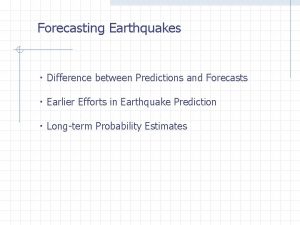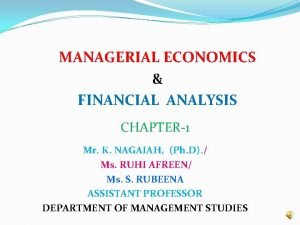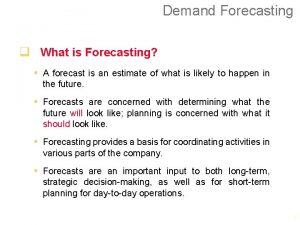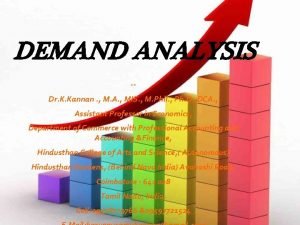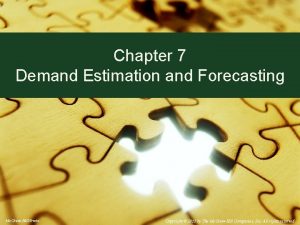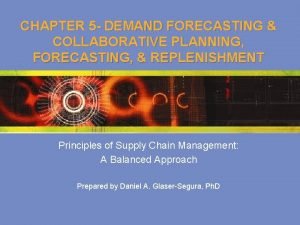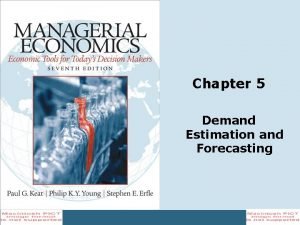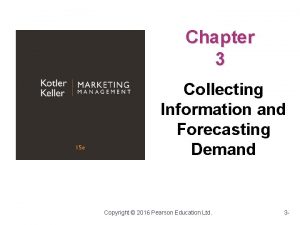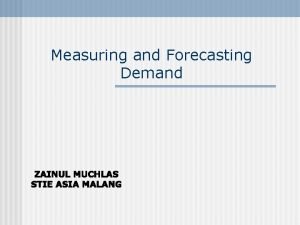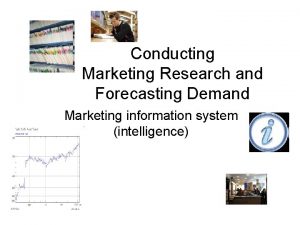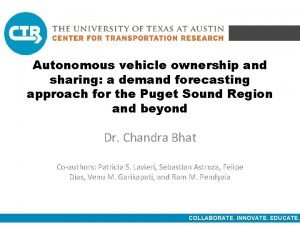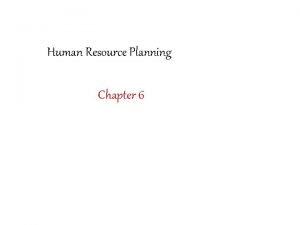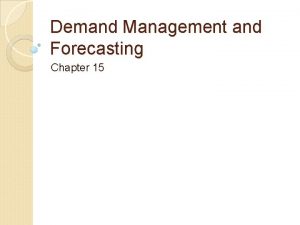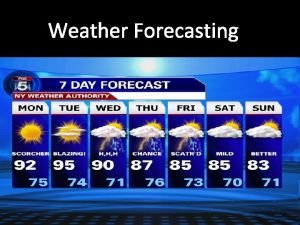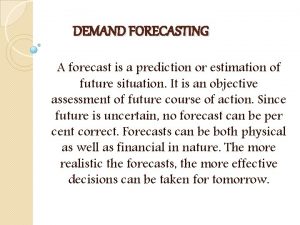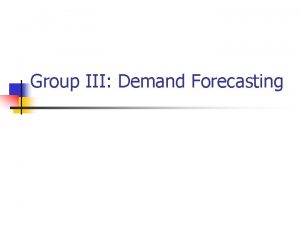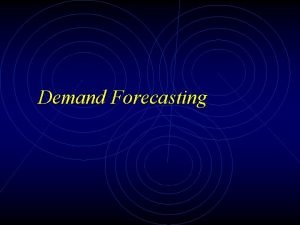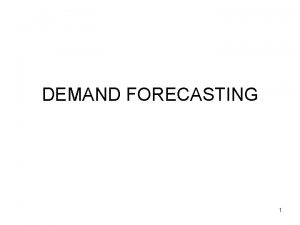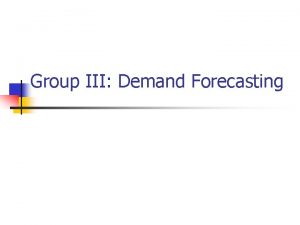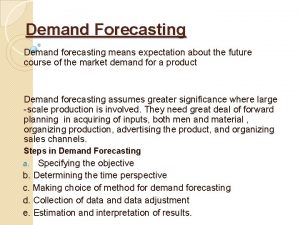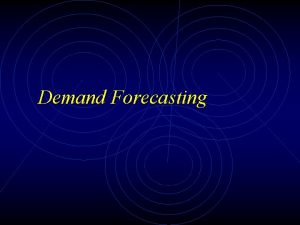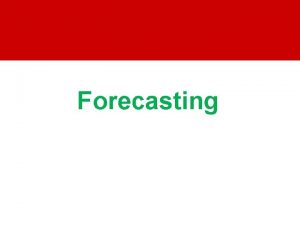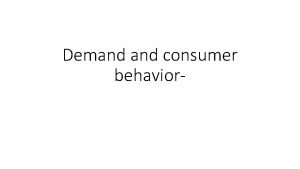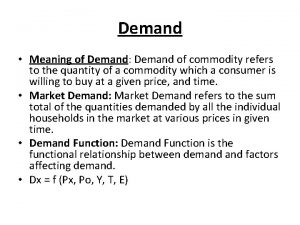DEMAND FORECASTING Meaning A forecast is a prediction
















- Slides: 16

DEMAND FORECASTING

Meaning… • A forecast is a prediction or estimation of future situation. It is an objective assessment of future course of action. Since future is uncertain, no forecast can be absolutely correct. • Demand forecasting refers to predicting the future demand for a particular product. • This helps in effective and efficient planning.

Importance. . . • Effective planning: provides scientific and reliable basis for anticipating future operations • Investment decision: investments are made keeping in mind the returns and the returns depend on the market demand. • Resource allocation: efficient allocation of resources when future estimates are available • Pricing decisions: in order to pursue optimal pricing strategies firm need to have complete information about future demand

Objectives of demand forecasting. . . Short-term • Formulation of Production policy • Proper availability of labour • Proper availability of raw materials • Price policy formulation Long-term • Labour requirements • Arrangement of funds • Expansion decisions

Techniques of Demand Forecasting Qualitative Quantitative

Qualitative Techniques • Based on expert opinion instead numeric analysis • Includes interpretation of data combined with the professional expertise developed over time on the job. • Examples include opinion survey method, executive judgement method, Delphi method, salesforce polling

Opinion survey method • In this method, the survey is conducted directly on the customers on their purchases and buying intentions. • This method requires extensive statistical analysis and can be timeconsuming and expensive. • However this method is quite useful forecasting demand of a new product.

Executive judgement method • The opinions of experts from different departments are considered and averaged to forecast the future sales. • This method of forecasting can be done easily and quickly without the necessity of elaborate statistics. • The main disadvantage is that it depends on individual opinions which can be very subjective and could lead to wrong forecasting.

Delphi method • It consists of an attempt to arrive at a consensus in an uncertain area by questioning a group of experts repeatedly until the responses appear to converge along a single line (consensus). • It is basically a more formal version of the jury of opinion method. • This method is very effective for long range forecasting. • The main disadvantage of this method is that from the returns there is lack of reliability.

Salesforce polling method • In this method, the forecast is done based on the opinions of salespeople who have steady interactions with the clients. • As they are closest to the customers, they can better predict the requirements of the customers for the future market. • The drawback is that the salespeople can be either optimistic or pessimistic about their predictions and this could lead to inaccurate forecasting.

Quantitative methods • It is a statistical technique to make predictions about the future which uses numerical measures and prior effects to predict future events. • These techniques are based on models of mathematics and in nature are mostly objective. • They are highly dependent on mathematical calculations. • Examples include trend projection, econometric methods, barometric method.

Trend Projection • This method assumes that the pattern of demand in the past will hold true for the future as well • This can be done using 2 techniques- graphical and least square • Trend analysis is often a quick method to gain insights into your business operations and obtain rough forecasts for key business variables. • However both accuracy and reliability of such forecasts suffer when the business environment changes

Barometric method • Economists use economic indicators as a barometer to forecast the overall trend in the business activities. • Some important indicators include employment, gross national product, wholesale prices, etc. • However the barometric technique can be used only for a short-term forecasting.

Econometric methods • It refers to the use of mathematical economic theory and statistical procedures. • This is a very complex method as it requires knowledge of maths, economics, and statistics • The forecast made through these methods is more reliable than the other forecasting methods.

Limitations of Demand Forecasting • • Forecasts are never 100% accurate It is a time-consuming process It is an expensive process Forecasting requires a lot of techniques and resources

The End Thank You
 Demand estimation techniques
Demand estimation techniques Difference between prediction and forecasting
Difference between prediction and forecasting Hotel demand forecasting
Hotel demand forecasting Statistical methods of demand forecasting
Statistical methods of demand forecasting Chain ratio method demand forecasting examples
Chain ratio method demand forecasting examples Importance of forecasting
Importance of forecasting Statistical methods of demand forecasting
Statistical methods of demand forecasting Demand estimation and forecasting
Demand estimation and forecasting The goal of cpfr is to
The goal of cpfr is to Demand estimation and forecasting
Demand estimation and forecasting Forecasting and demand measurement in marketing
Forecasting and demand measurement in marketing Measuring and forecasting demand
Measuring and forecasting demand Market research demand forecasting
Market research demand forecasting Forecasting demand for autonomous vehicles
Forecasting demand for autonomous vehicles Ninety types of demand measurement
Ninety types of demand measurement Objectives of hrp
Objectives of hrp Demand forecasting objectives
Demand forecasting objectives

